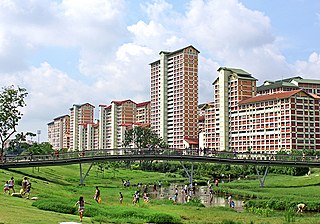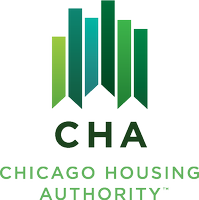Related Research Articles

Public housing, also known as social housing, refers to affordable housing provided in buildings that are usually owned and managed by local government, central government, nonprofit organizations or a combination thereof. The details, terminology, definitions of poverty, and other criteria for allocation may vary within different contexts, but the right to rent such a home is generally rationed through some form of means-testing or through administrative measures of housing needs. One can regard social housing as a potential remedy for housing inequality. Within the OECD, social housing represents an average of 7% of national housing stock (2020), ranging from ~34% in the Netherlands to less than 1% in Colombia.
Section 8 of the Housing Act of 1937, commonly known as Section 8, provides rental housing assistance to low-income households in the United States by paying private landlords on behalf of these tenants. Approximately 68% of this assistance benefits seniors, children, and individuals with disabilities. The Department of Housing and Urban Development (HUD) oversees Section 8 programs, which are administered locally by public housing agencies (PHAs).

The Office of Public and Indian Housing (PIH) is an agency of the U.S. Department of Housing and Urban Development. Its mission is to ensure safe, decent, and affordable housing, create opportunities for residents' self-sufficiency and economic independence, and assure the fiscal integrity of all program participants.
Subsidized housing is government sponsored economic assistance aimed towards alleviating housing costs and expenses for impoverished people with low to moderate incomes. In the United States, subsidized housing is often called "affordable housing". Forms of subsidies include direct housing subsidies, non-profit housing, public housing, rent supplements/vouchers, and some forms of co-operative and private sector housing. According to some sources, increasing access to housing may contribute to lower poverty rates.

The New York City Housing Authority (NYCHA) is a public development corporation which provides public housing in New York City, and is the largest public housing authority in North America. Created in 1934 as the first agency of its kind in the United States, it aims to provide decent, affordable housing for low- and moderate-income New Yorkers throughout the five boroughs of New York City. NYCHA also administers a citywide Section 8 Leased Housing Program in rental apartments. NYCHA developments include single and double family houses, apartment units, singular floors, and shared small building units, and commonly have large income disparities with their respective surrounding neighborhood or community. These developments, particularly those including large-scale apartment buildings, are often referred to in popular culture as "projects."
HOPE VI is a program of the United States Department of Housing and Urban Development. It is intended to revitalize the most distressed public housing projects in the United States into mixed-income developments. Its philosophy is largely based on New Urbanism and the concept of defensible space.

The Chicago Housing Authority (CHA) is a municipal corporation that oversees public housing within the city of Chicago. The agency's Board of Commissioners is appointed by the city's mayor, and has a budget independent from that of the city of Chicago. CHA is the largest rental landlord in Chicago, with more than 50,000 households. CHA owns over 21,000 apartments. It also oversees the administration of 37,000 Section 8 vouchers. The current acting CEO of the Chicago Housing Authority is Tracey Scott.
The Atlanta Housing Authority (AHA) is an agency that provides affordable housing for low-income families in Atlanta. Today, the AHA is the largest housing agency in Georgia and one of the largest in the United States, serving approximately 50,000 people.
The Prospect Plaza Houses was a 4.53-acre (18,300 m2) complex owned by the New York City Housing Authority (NYCHA) in the Ocean Hill section of Brooklyn and was bordered by St. Marks and Sterling Place, Howard and Saratoga Avenues. It was the first NYCHA development to be completely demolished.

The Texas Department of Housing and Community Affairs (TDHCA) is the state's lead agency responsible for homeownership, affordable rental housing, community and energy assistance programs, and colonia activities serving primarily low income Texans. The Manufactured Housing Division of TDHCA regulates the manufactured housing industry in Texas. The Department annually administers more than $400 million through for-profit, nonprofit, and local government partnerships to deliver local housing and community-based opportunities and assistance to Texans in need. The department is headquartered at 221 East 11th Street in Austin.

The Housing Act of 1937, formally the "United States Housing Act of 1937" and sometimes called the Wagner–Steagall Act, provided for subsidies to be paid from the United States federal government to local public housing agencies (LHAs) to improve living conditions for low-income families.

In the United States, subsidized housing is administered by federal, state and local agencies to provide subsidized rental assistance for low-income households. Public housing is priced much below the market rate, allowing people to live in more convenient locations rather than move away from the city in search of lower rents. In most federally-funded rental assistance programs, the tenants' monthly rent is set at 30% of their household income. Now increasingly provided in a variety of settings and formats, originally public housing in the U.S. consisted primarily of one or more concentrated blocks of low-rise and/or high-rise apartment buildings. These complexes are operated by state and local housing authorities which are authorized and funded by the United States Department of Housing and Urban Development (HUD). In 2020, there were one million public housing units. In 2022, about 5.2 million American households received some form of federal rental assistance.

The Office of Fair Housing and Equal Opportunity (FHEO) is an agency within the United States Department of Housing and Urban Development. FHEO is responsible for administering and enforcing federal fair housing laws and establishing policies that make sure all Americans have equal access to the housing of their choice.
The Boston Housing Authority (BHA) is a public agency within the city of Boston, Massachusetts that provides subsidized public housing to low- and moderate-income families and individuals. The BHA is not a municipal agency, but a separate local entity.
Non-profit housing developers build affordable housing for individuals under-served by the private market. The non-profit housing sector is composed of community development corporations (CDC) and national and regional non-profit housing organizations whose mission is to provide for the needy, the elderly, working households, and others that the private housing market does not adequately serve. Of the total 4.6 million units in the social housing sector, non-profit developers have produced approximately 1.547 million units, or roughly one-third of the total stock. Since non-profit developers seldom have the financial resources or access to capital that for-profit entities do, they often use multiple layers of financing, usually from a variety of sources for both development and operation of these affordable housing units.

Howard County Housing is the umbrella organization for the Howard County Department of Housing and Community Development and the Howard County Housing Commission. The Department is Howard County Government’s housing agency, and the Commission is a public housing authority and non-profit. Both have boards that meet monthly.

The District of Columbia Housing Authority is an independent government agency whose mission is to provide affordable housing to extremely low- through moderate-income households, foster sustainable communities, and cultivate opportunities for residents to improve their lives throughout the eight wards of Washington, D.C.

Queen Lane Apartments opened in 1955 as one of several Post-War public housing hi-rise complexes in Philadelphia, Pennsylvania which were built and maintained by the Philadelphia Housing Authority (PHA). The PHA demolished the Queen Lane high-rise on September 13, 2014. The PHA replaced it with 55 new, affordable rental units for individuals and families. The first of the new 55 units were opened on December 15, 2015. Mayor Michael Nutter, City Council President Darrell L. Clarke, City Councilwoman Cindy Bass, PHA President/CEO Kelvin Jeremiah, residents of the nine new units, and other dignitaries joined together to cut the ribbon.
The Rental Assistance Demonstration is a federal housing program that was enacted as part of the Consolidated and Further Continuing Appropriations Act, 2012, and is administered by the U.S. Department of Housing & Urban Development (HUD). Broadly, the purpose of the Rental Assistance Demonstration is to provide a set of tools to address the unmet capital needs of deeply affordable, federally assisted rental housing properties in order to maintain both the viability of the properties and their long-term affordability. It also simplifies the administrative oversight of the properties by the federal government. Specifically, RAD authorizes the conversion of a property's federal funding from one form to another, where the initial form presents structural impediments to private capital investment and the new form is not only familiar to lenders and investors but, since its enactment in 1974, has leveraged billions in private investment for the development and rehabilitation of deeply affordable rental housing.

The Holyoke Housing Authority (HHA) is a public agency of the city of Holyoke, Massachusetts that provides subsidized public housing to low- and moderate-income families and individuals.
References
- ↑ "Troy Housing Authority: About". City of Troy. Retrieved March 1, 2020.
- ↑ Anderson, Eric (April 30, 2019). "Vacant Troy towers' days may be numbered". Times Union. Retrieved March 1, 2020.
- ↑ DeMasi, Michael (November 1, 2019). "Philadelphia company picked to redevelop Troy's Taylor Apartments". Albany Business Review. Retrieved March 1, 2020.
- ↑ "Troy Housing Authority". City of Troy. Retrieved March 1, 2020.